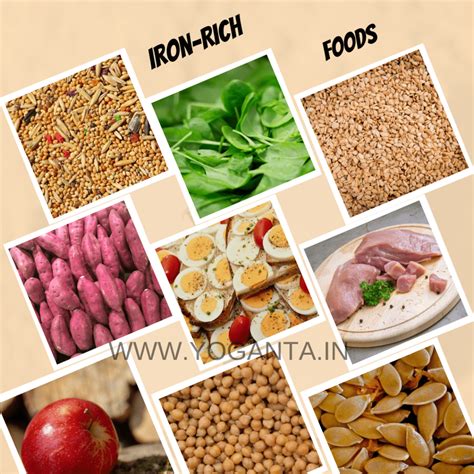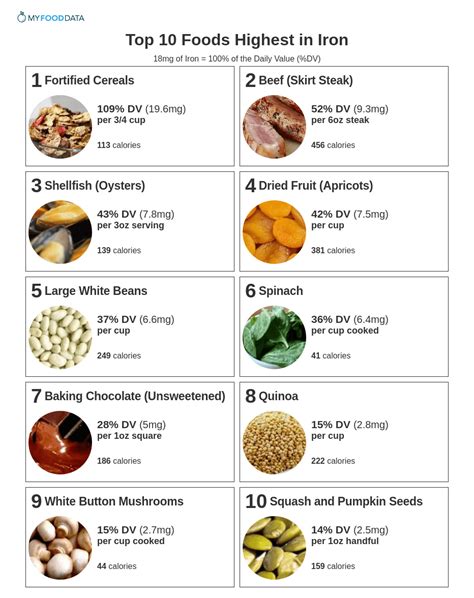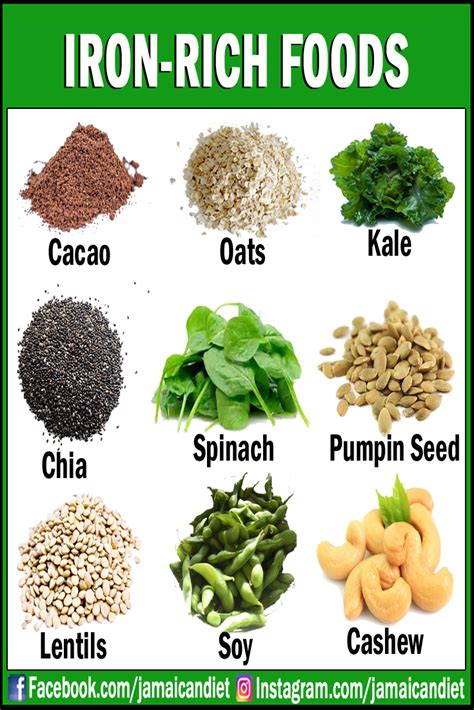Intro
Boost iron intake with 5 iron-rich foods, including spinach, beans, and red meat, to combat anemia and fatigue, promoting healthy red blood cells and oxygen flow, with these nutrient-dense iron sources.
Iron is an essential nutrient that plays a vital role in maintaining healthy red blood cells, which carry oxygen throughout the body. Without sufficient iron, individuals may experience fatigue, weakness, and other health issues. Fortunately, there are many delicious and iron-rich foods that can help meet daily iron needs. In this article, we will explore the importance of iron, its benefits, and provide a list of iron-rich foods that can be easily incorporated into a healthy diet.
Iron deficiency is a common nutritional disorder that affects millions of people worldwide. It can be caused by a lack of iron in the diet, increased iron requirements, or iron loss due to certain medical conditions. Iron deficiency can lead to anemia, a condition characterized by a decrease in red blood cells or the amount of hemoglobin in the blood. Anemia can cause a range of symptoms, including fatigue, shortness of breath, and pale skin.
A well-balanced diet that includes iron-rich foods can help prevent iron deficiency and anemia. Iron-rich foods are divided into two categories: heme iron sources, which are animal-based, and non-heme iron sources, which are plant-based. Heme iron sources are more easily absorbed by the body, while non-heme iron sources require vitamin C to enhance absorption. In this article, we will discuss the benefits of iron-rich foods, provide examples of heme and non-heme iron sources, and offer tips on how to increase iron intake.
Benefits of Iron Rich Foods

Some of the key benefits of iron-rich foods include:
- Reducing the risk of iron deficiency and anemia
- Boosting energy levels and reducing fatigue
- Improving cognitive function and concentration
- Supporting immune function and reducing the risk of infections
- Maintaining healthy skin, hair, and nails
Top 5 Iron Rich Foods

Other Iron Rich Foods
In addition to the top 5 iron-rich foods, there are many other foods that are rich in iron. Some examples include: * Fish and seafood, such as shrimp, tuna, and sardines * Nuts and seeds, such as pumpkin seeds, sesame seeds, and sunflower seeds * Beans and legumes, such as kidney beans, black beans, and chickpeas * Whole grains, such as brown rice, quinoa, and whole wheat breadIncreasing Iron Intake

It is also important to note that vitamin C can enhance non-heme iron absorption, while calcium and milk products can inhibit it. Therefore, it is recommended to consume vitamin C-rich foods with iron-rich plant-based foods and avoid consuming dairy products with iron-rich plant-based foods.
Iron Deficiency and Anemia
Iron deficiency and anemia are common nutritional disorders that can have serious health consequences if left untreated. Iron deficiency can cause a range of symptoms, including fatigue, weakness, and shortness of breath. Anemia can also increase the risk of infections, poor pregnancy outcomes, and impaired cognitive function.If you suspect that you have iron deficiency or anemia, it is essential to consult with a healthcare professional for proper diagnosis and treatment. Iron supplements may be necessary to treat iron deficiency and anemia, but they should only be taken under the guidance of a healthcare professional.
Conclusion and Final Thoughts

We hope that this article has provided you with valuable information on the importance of iron-rich foods and how to increase your iron intake. If you have any questions or comments, please feel free to share them below. Also, don't forget to share this article with your friends and family to help spread the word about the importance of iron-rich foods.
What are the symptoms of iron deficiency?
+The symptoms of iron deficiency include fatigue, weakness, shortness of breath, and pale skin. If left untreated, iron deficiency can lead to anemia, which can cause more severe symptoms, such as poor appetite, rapid heartbeat, and poor immune function.
How can I increase my iron intake?
+You can increase your iron intake by eating iron-rich foods regularly, cooking in cast iron cookware, and avoiding tea and coffee with meals. Vitamin C can also enhance non-heme iron absorption, so consuming vitamin C-rich foods with iron-rich plant-based foods can help increase iron intake.
What are the best iron supplements?
+The best iron supplements are those that are prescribed by a healthcare professional and taken under their guidance. Iron supplements can be necessary to treat iron deficiency and anemia, but they should only be taken if necessary and under the guidance of a healthcare professional.
